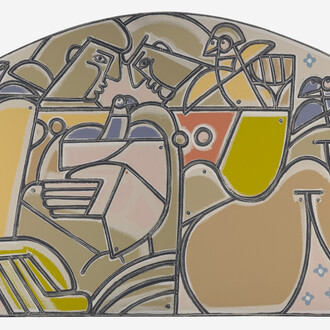In the spring gallery season of 2025, Lisa Sette Gallery blazes into its fourth decade of exhibiting exhilarating new art, shaping the cultural character of the city, and gathering community around aesthetic and philosophical experimentation. An expansive group show and celebration will honor this milestone, with an opening reception with artists on Saturday, March 8th, 2025 continuing through Saturday, May 31st, 2025. Artists will include: Kim Cridler, Ala Ebtekar, Angela Ellsworth, Carlos Estevez, Timothy Horn, Siri Devi Khandavilli, Mark Klett, Mayme Kratz, David Kroll, Carrie Marill, Marie Navarre, Charlotte Potter, Julianne Swartz, Benjamin Timpson, James Turrell, and William Wegman, among others.
As the 40th year anniversary exhibition demonstrates in challenging and inspiring works, the gallery has weathered a notoriously difficult market, celebrated a significant change of venue, and continues to serve as a welcoming locus of creative culture in the city. This ongoing project is personal for founder and curator Lisa Sette, who started her gallery in 1985. Reflecting on her tenure, Sette remarks that the gallery is her way of “reacting, processing, exploring–kind of in the same way that an artist does–with the end result hopefully effecting change. I’m naturally curious and I learn about the world through art. I always have and probably always will. I don't know any other way”.
Forty years in, Lisa Sette Gallery boasts an artist roster that expands with new discoveries as well as retaining longtime, loyal artists, many of whom are now considered contemporary canon–the gallery’s advanced-career artists include luminaries Enrique Chagoya, Sonya Clark, Angela Ellsworth, Mark Klett, Mayme Kratz, James Turrell, and William Wegman, most of whom have worked with the gallery for decades. As cultural connections and interactions in the world at large have become increasingly complex over the last decades, Lisa Sette Gallery has responded with expansive curatorial visions and bold statements, including the recent group shows Subversive white, Tell me why, and The moon is a lantern, many of which unflinchingly commented on contemporary political conflict–“My intolerance for injustice is at an all-time high right now”, Sette remarks. The gallery has also brought to light work from young artists from many countries, including recent Cuban expat Reynier Leyva Novo, Ghanaian-American sculptor Ato Riberio, and Indian artist Siri Devi Khandavilli.
Sette reflects, “I don’t really think of myself as a ‘curator’ in terms of formal training, but in fact, I curate just about everything related to my business–artists and particular works by artists that resonate with me, my wonderful staff, our schedule of exhibitions. In all of these activities my process comes from an idea or a concept, and I’m following a path from that idea to an exhibition. And often, as I do this, I’m responding to the times in which we live”.
A recent exhibit that had a profound effect on Sette personally was a solo exhibit of the works of Benjamin Timpson, who recreates photographs of missing or murdered Indigenous women using deconstructed and intricately arranged butterfly wings. Sette remarks: “Ben’s exhibition and work with the families of abused, missing and murdered Indigenous women had a tremendous impact on me. It was one of the most poignant bodies of work we have ever shown. Several families of the victims, generations of families, actually, attended the opening and closing of the show. It was extremely moving on every level, particularly for me as a mother of young women”.
Responding to the current moment is a quality that Lisa Sette Gallery is known for, and the gallery’s early shows were no less intrepid; Gene Cooper’s 1996 The natural Bardo used pioneering technology to connect the artist’s vital signs to a massive wooden clock driven by the heartbeat of both the artist and viewers alike - a visceral reminder that human survival is inextricably connected to the tending of the environment and the pursuit of scientific progress. Frances Whitehead’s 1999 exhibit Arguably alive presented a luxuriant display of faience vessels in the style of ancient Egyptian canopic (mummification) jars, with each urn representing deadly viruses. “Looking back at these installations”, Sette says, “I understand how truly prescient artists are–how they are very much at the forefront of discovery and how fortunate we are that they can translate these concerns into works of art”.
Another recent milestone was the gallery’s 2014 move from its space in Scottsdale to a magnificently renovated Al Beadle-designed building in Midtown Phoenix. Sette collaborated with architect Wesley James to revive the building—originally intended as an office-space—with a series of careful renovations, including an open interior that preserves Beadle’s original steel-beam ceiling and presents expansive spaces for showing art in diverse media. Sette and James also added a massive fabric scrim around the gallery’s exterior; the result is a structure that seems to emerge from the urban desert floor with a luminescence and boldness that parallels the gallery’s interior explorations.
Lisa Sette Gallery’s 40 year anniversary exhibition: shaping a life of curiosity will celebrate these transformations and more to come, as the gallery presents a template for moving fearlessly and creatively into the complex new landscape of the 21st Century.















